Contents
- 1. users manual 1
- 2. users manual 2
- 3. users manual 3
- 4. users manual 4
users manual 1
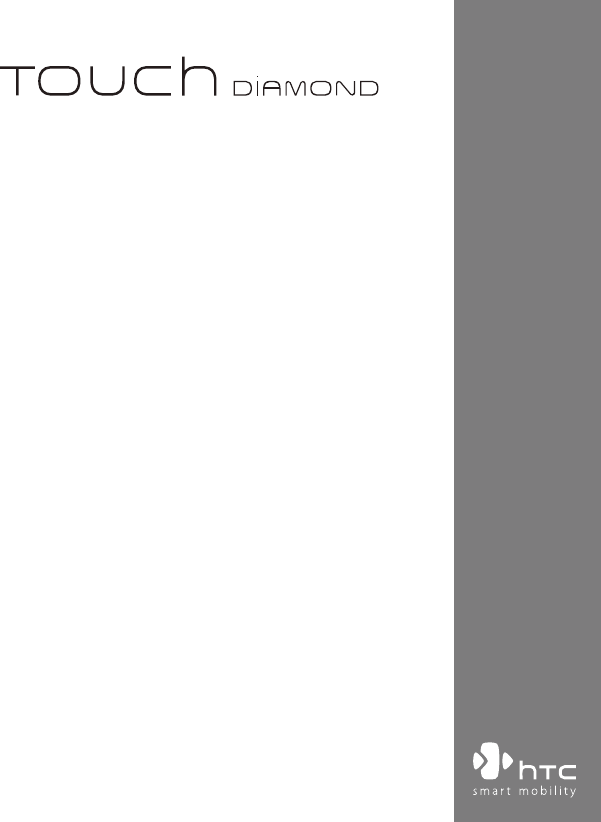
www.htc.com
User Manual

2
Please Read Before Proceeding
THE BATTERY IS NOT CHARGED WHEN YOU TAKE IT OUT OF THE BOX.
DO NOT REMOVE THE BATTERY PACK WHEN THE DEVICE IS CHARGING.
YOUR WARRANTY IS INVALIDATED IF YOU OPEN OR TAMPER WITH THE
DEVICE’S OUTER CASING.
PRIVACY RESTRICTIONS
Some countries require full disclosure of recorded telephone conversations,
and stipulate that you must inform the person with whom you are speaking
that the conversation is being recorded. Always obey the relevant laws and
regulations of your country when using the recording feature of your PDA
Phone.
INTELLECTUAL PROPERTY RIGHT INFORMATION
Copyright © 2008 High Tech Computer Corp. All Rights Reserved.
, , , ExtUSB, and HTC Care are trademarks and/or service
marks of High Tech Computer Corp.
Microsoft, MS-DOS, Windows, Windows NT, Windows Server, Windows
Mobile, Windows XP, Windows Vista, ActiveSync, Windows Mobile Device
Center, Internet Explorer, MSN, Hotmail, Windows Live, Outlook, Excel,
PowerPoint, Word, OneNote and Windows Media are either registered
trademarks or trademarks of Microsoft Corporation in the United States
and/or other countries.
Bluetooth and the Bluetooth logo are trademarks owned by Bluetooth SIG,
Inc.
Java, J2ME and all other Java-based marks are trademarks or registered
trademarks of Sun Microsystems, Inc. in the United States and other
countries.
Copyright © 2008, Adobe Systems Incorporated. All Rights Reserved.
Opera® Mobile from Opera Software ASA. Copyright 1995-2008 Opera
Software ASA. All Rights Reserved.
Google is a registered trademark and Google Maps is a trademark of
Google, Inc. in the United States and other countries.
3
YouTube is a trademark of Google, Inc.
Sprite Backup is a trademark or service mark of Sprite Software.
Copyright © 2001-2008, Spb Software House. All Rights Reserved.
Copyright © 2008, Esmertec AG. All Rights Reserved.
Copyright © 2003-2008, ArcSoft, Inc. and its licensors. All Rights Reserved.
ArcSoft and the ArcSoft logo are registered trademarks of ArcSoft, Inc. in the
United States and/or other countries.
Copyright © 2004-2008, Ilium Software, Inc. All Rights Reserved.
All other company, product and service names mentioned herein are
trademarks, registered trademarks or service marks of their respective
owners.
HTC shall not be liable for technical or editorial errors or omissions
contained herein, nor for incidental or consequential damages resulting
from furnishing this material. The information is provided “as is” without
warranty of any kind and is subject to change without notice. HTC also
reserves the right to revise the content of this document at any time
without prior notice.
No part of this document may be reproduced or transmitted in any form or
by any means, electronic or mechanical, including photocopying, recording
or storing in a retrieval system, or translated into any language in any form
without prior written permission of HTC.
4
Disclaimers
THE WEATHER INFORMATION, DATA AND DOCUMENTATION ARE PROVIDED
“AS IS” AND WITHOUT WARRANTY OR TECHNICAL SUPPORT OF ANY KIND
FROM HTC. TO THE MAXIMUM EXTENT PERMITTED BY APPLICABLE LAW,
HTC AND ITS AFFILIATES expressly disclaim any and all representations
and warranties, express or implied, arising by law or otherwise, regarding
the Weather Information, Data, Documentation, or any other Products
and services, including without limitation any express or implied warranty
of merchantability, express or implied warranty of fitness for a particular
purpose, non-infringement, quality, accuracy, completeness, effectiveness,
reliability, usefulness, that the Weather Information, Data and/or
Documentation will be error-free, or implied warranties arising from course
of dealing or course of performance.
Without limiting the foregoing, it is further understood that HTC and
its Providers are not responsible for Your use or misuse of the Weather
Information, Data and/or Documentation or the results from such use.
HTC and its Providers make no express or implied warranties, guarantees
or affirmations that weather information will occur or has occurred as
the reports, forecasts, data, or information state, represent or depict and
it shall have no responsibility or liability whatsoever to any person or
entity, parties and non-parties alike, for any inconsistency, inaccuracy, or
omission for weather or events predicted or depicted, reported, occurring
or occurred. WITHOUT LIMITING THE GENERALITY OF THE FOREGOING,
YOU ACKNOWLEDGE THAT THE WEATHER INFORMATION, DATA AND/OR
DOCUMENTATION MAY INCLUDE INACCURACIES AND YOU WILL USE
COMMON SENSE AND FOLLOW STANDARD SAFETY PRECAUTIONS IN
CONNECTION WITH THE USE OF THE WEATHER INFORMATION, DATA OR
DOCUMENTATION.
5
Limitation of Damages
TO THE MAXIMUM EXTENT PERMITTED BY APPLICABLE LAW, IN NO EVENT
SHALL HTC OR ITS PROVIDERS BE LIABLE TO USER OR ANY THIRD PARTY
FOR ANY INDIRECT, SPECIAL, CONSEQUENTIAL, INCIDENTAL OR PUNITIVE
DAMAGES OF ANY KIND, IN CONTRACT OR TORT, INCLUDING, BUT NOT
LIMITED TO, INJURY, LOSS OF REVENUE, LOSS OF GOODWILL, LOSS OF
BUSINESS OPPORTUNITY, LOSS OF DATA, AND/OR LOSS OF PROFITS
ARISING OUT OF, OR RELATED TO, IN ANY MANNER, OR THE DELIVERY,
PERFORMANCE OR NONPERFORMANCE OF OBLIGATIONS, OR USE OF
THE WEATHER INFORMATION, DATA OR DOCUMENTATION HEREUNDER
REGARDLESS OF THE FORESEEABILITY THEREOF.
Important Health Information and Safety Precautions
When using this product, the safety precautions below must be taken to
avoid possible legal liabilities and damages.
Retain and follow all product safety and operating instructions. Observe all
warnings in the operating instructions on the product.
To reduce the risk of bodily injury, electric shock, fire, and damage to the
equipment, observe the following precautions.
ELECTRICAL SAFETY
This product is intended for use when supplied with power from the
designated battery or power supply unit. Other usage may be dangerous
and will invalidate any approval given to this product.
SAFETY PRECAUTIONS FOR PROPER GROUNDING INSTALLATION
CAUTION: Connecting to an improperly grounded equipment can result in
an electric shock to your device.
This product equipped with a USB Cable for connecting with desktop or
notebook computer. Be sure your computer is properly grounded (earthed)
before connecting this product to the computer. The power supply cord of
a desktop or notebook computer has an equipment-grounding conductor
and a grounding plug. The plug must be plugged into an appropriate outlet
which is properly installed and grounded in accordance with all local codes
and ordinances.
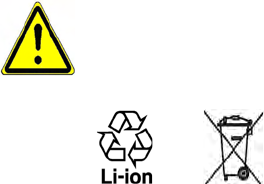
6
SAFETY PRECAUTIONS FOR POWER SUPPLY UNIT
• Use the correct external power source
A product should be operated only from the type of power source
indicated on the electrical ratings label. If you are not sure of the type
of power source required, consult your authorized service provider or
local power company. For a product that operates from battery power
or other sources, refer to the operating instructions that are included
with the product.
• Handle battery packs carefully
This product contains a Li-ion battery. There is a risk of fire and burns
if the battery pack is handled improperly. Do not attempt to open or
service the battery pack. Do not disassemble, crush, puncture, short
external contacts or circuits, dispose of in fire or water, or expose a
battery pack to temperatures higher than 60˚C (140˚F).
WARNING: Danger of explosion if battery is incorrectly replaced.
To reduce risk of fire or burns, do not disassemble, crush, puncture,
short external contacts, expose to temperature above 60° C (140° F),
or dispose of in fire or water. Replace only with specified batteries.
Recycle or dispose of used batteries according to the local regulations
or reference guide supplied with your product.
• Take extra precautions
• Keep the battery or device dry and away from water or any liquid
as it may cause a short circuit.
• Keep metal objects away so they don’t come in contact with the
battery or its connectors as it may lead to short circuit during
operation.
• Do not use a battery that appears damaged, deformed, or
discolored, or the one that has any rust on its casing, overheats, or
emits a foul odor.

7
• Always keep the battery out of the reach of babies and small
children, to avoid swallowing of the battery. Consult the doctor
immediately if the battery is swallowed.
• If the battery leaks:
• Do not allow the leaking fluid to come in contact with skin
or clothing. If already in contact, flush the affected area
immediately with clean water and seek medical advice.
• Do not allow the leaking fluid to come in contact with eyes.
If already in contact, DO NOT rub; rinse with clean water
immediately and seek medical advice.
• Take extra precautions to keep a leaking battery away from fire
as there is a danger of ignition or explosion.
SAFETY PRECAUTIONS FOR DIRECT SUNLIGHT
Keep this product away from excessive moisture and extreme temperatures.
Do not leave the product or its battery inside a vehicle or in places where
the temperature may exceed 60°C (140°F), such as on a car dashboard,
window sill, or behind a glass that is exposed to direct sunlight or strong
ultraviolet light for extended periods of time. This may damage the product,
overheat the battery, or pose a risk to the vehicle.
PREVENTION OF HEARING LOSS
CAUTION: Permanent hearing loss may occur if earphones or
headphones are used at high volume for prolonged periods
of time.
NOTE: For France, Earphone (listed below) for this device have been tested
to comply with the Sound Pressure Level requirement laid down in the
applicable NF EN 50332-1:2000 and/or NF EN 50332-2:2003 standards as
required by French Article L. 5232-1.
• Earphone, manufactured by HTC, Model HS S300.
8
SAFETY IN AIRCRAFT
Due to the possible interference caused by this product to an aircraft’s
navigation system and its communications network, using this device’s
phone function on board an airplane is against the law in most countries. If
you want to use this device when on board an aircraft, remember to turn off
your phone by switching to Airplane Mode.
ENVIRONMENT RESTRICTIONS
Do not use this product in gas stations, fuel depots, chemical plants or
where blasting operations are in progress, or in potentially explosive
atmospheres such as fuelling areas, fuel storehouses, below deck on
boats, chemical plants, fuel or chemical transfer or storage facilities, and
areas where the air contains chemicals or particles, such as grain, dust, or
metal powders. Please be aware that sparks in such areas could cause an
explosion or fire resulting in bodily injury or even death.
EXPLOSIVE ATMOSPHERES
When in any area with a potentially explosive atmosphere or where
flammable materials exist, the product should be turned off and the user
should obey all signs and instructions. Sparks in such areas could cause an
explosion or fire resulting in bodily injury or even death. Users are advised
not to use the equipment at refueling points such as service or gas stations,
and are reminded of the need to observe restrictions on the use of radio
equipment in fuel depots, chemical plants, or where blasting operations
are in progress. Areas with a potentially explosive atmosphere are often,
but not always, clearly marked. These include fueling areas, below deck on
boats, fuel or chemical transfer or storage facilities, and areas where the air
contains chemicals or particles, such as grain, dust, or metal powders.
ROAD SAFETY
Vehicle drivers in motion are not permitted to use telephony services with
handheld devices, except in the case of emergency. In some countries,
using hands-free devices as an alternative is allowed.
SAFETY PRECAUTIONS FOR RF EXPOSURE
• Avoid using your phone near metal structures (for example, the steel
frame of a building).
• Avoid using your phone near strong electromagnetic sources, such as
microwave ovens, sound speakers, TV and radio.
9
• Use only original manufacturer-approved accessories, or accessories
that do not contain any metal.
• Use of non-original manufacturer-approved accessories may violate
your local RF exposure guidelines and should be avoided.
INTERFERENCE WITH MEDICAL EQUIPMENT FUNCTIONS
This product may cause medical equipment to malfunction. The use of this
device is forbidden in most hospitals and medical clinics.
If you use any other personal medical device, consult the manufacturer
of your device to determine if they are adequately shielded from external
RF energy. Your physician may be able to assist you in obtaining this
information.
Turn your phone OFF in health care facilities when any regulations posted
in these areas instruct you to do so. Hospitals or health care facilities may be
using equipment that could be sensitive to external RF energy.
HEARING AIDS
Some digital wireless phones may interfere with some hearing aids. In the
event of such interference, you may want to consult your service provider,
or call the customer service line to discuss alternatives.
NONIONIZING RADIATION
Your device has an internal antenna. This product should be operated in
its normal-use position to ensure the radiative performance and safety
of the interference. As with other mobile radio transmitting equipment,
users are advised that for satisfactory operation of the equipment and
for the safety of personnel, it is recommended that no part of the human
body be allowed to come too close to the antenna during operation of the
equipment.
Use only the supplied integral antenna. Use of unauthorized or modified
antennas may impair call quality and damage the phone, causing loss of
performance and SAR levels exceeding the recommended limits as well
as result in non-compliance with local regulatory requirements in your
country.
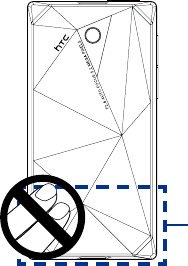
10
To assure optimal phone
performance and ensure
human exposure to RF energy
is within the guidelines set
forth in the relevant standards,
always use your device only
in its normal-use position. Do
not touch or hold the antenna
area unnecessarily when
placing or receiving a phone
call. Contact with the antenna
area may impair call quality and
cause your device to operate
at a higher power level than
needed. Avoiding contact with
the antenna area when the
phone is IN USE optimizes the
antenna performance and the
battery life.
General Precautions
• Avoid applying excessive pressure to the device
Do not put heavy objects or apply excessive pressure on the device to
prevent damaging the device or distorting the touch screen display.
Also avoid carrying the device inside your pocket for extensive
lengths of time.
• Device getting warm after prolonged use
When using your device for prolonged periods of time, such as when
you’re talking on the phone, charging the battery or browsing the web,
the device may become warm. In most cases, this condition is normal
and therefore should not be interpreted as a problem with the device.
• Heed service markings
Except as explained elsewhere in the Operating or Service
documentation, do not service any product yourself. Service needed
on components inside the device should be done by an authorized
service technician or provider.
Antenna location
11
• Damage requiring service
Unplug the product from the electrical outlet and refer servicing to
an authorized service technician or provider under the following
conditions:
• Liquid has been spilled or an object has fallen into the product.
• The product has been exposed to rain or water.
• The product has been dropped or damaged.
• There are noticeable signs of overheating.
• The product does not operate normally when you follow the
operating instructions.
• Avoid hot areas
The product should be placed away from heat sources such as
radiators, heat registers, stoves, or other products (including
amplifiers) that produce heat.
• Avoid wet areas
Never use the product in a wet location.
• Avoid using your device after a dramatic change in temperature
When you move your device between environments with very
different temperature and/or humidity ranges, condensation may
form on or within the device. To avoid damaging the device, allow
sufficient time for the moisture to evaporate before using the device.
NOTICE: When taking the device from low-temperature conditions into a
warmer environment or from high-temperature conditions into
a cooler environment, allow the device to acclimate to room
temperature before turning on power.
• Avoid pushing objects into product
Never push objects of any kind into cabinet slots or other openings
in the product. Slots and openings are provided for ventilation. These
openings must not be blocked or covered.
• Mounting accessories
Do not use the product on an unstable table, cart, stand, tripod,
or bracket. Any mounting of the product should follow the
manufacturer’s instructions, and should use a mounting accessory
recommended by the manufacturer.

12
• Avoid unstable mounting
Do not place the product with an unstable base.
• Use product with approved equipment
This product should be used only with personal computers and
options identified as suitable for use with your equipment.
• Adjust the volume
Turn down the volume before using headphones or other audio
devices.
• Cleaning
Unplug the product from the wall outlet before cleaning. Do not use
liquid cleaners or aerosol cleaners. Use a damp cloth for cleaning, but
NEVER use water to clean the LCD screen.
• For magnetic devices
Please avoid putting any media that contains magnets,
e.g. magnetic card, credit cards, bank cards, audio/
video tape or magnetic memory devices, directly on
the device or stylus without any distance.
It is highly recommended to put the media containing
magnets in a security distance of at least 5 cm. If you
carry your wallet or billfold which contains magnetic
cards next to the device or its stylus, information
stored on these cards could be destroyed.
Please make sure that there is an adequate distance between
the device or its stylus and other magnetic sensitive devices,
e.g., a mechanical watch or measure instruments.
• For pacemakers
The functionality of pacemakers can be interfered by
the device and its stylus. Always keep the device and
its stylus in a fair distance to your pacemaker, which
at least will be 5 cm. In any case, please do not carry
the device and/or its stylus in the front pockets of your
shirt or coat.
For information about other medical active implants,
please contact the producer or a doctor to ensure such
active implants will not be interfered by magnetic field.
13
Contents
Chapter 1 Getting Started 21
1.1 Getting to Know Your Touch Phone and Accessories ......................... 22
Top panel ......................................................................................................................22
Left panel ......................................................................................................................22
Right panel ...................................................................................................................22
Front panel ...................................................................................................................23
Back panel ....................................................................................................................24
Bottom panel...............................................................................................................24
Accessories ...................................................................................................................25
1.2 Installing the SIM Card and Battery .................................................... 25
SIM card .........................................................................................................................25
Battery............................................................................................................................26
1.3 Charging the battery ............................................................................ 28
1.4 Using the Strap Holder ......................................................................... 29
1.5 Starting Up ............................................................................................ 30
Turn your device on and off ...................................................................................30
Auto configure the data connection settings .................................................30
Switch to Sleep mode when not in use .............................................................31
1.6 Navigating Your Device ........................................................................ 32
Finger-touch control .................................................................................................32
Stylus ..............................................................................................................................34
Navigation Control ....................................................................................................34
1.7 Home Screen ......................................................................................... 35
1.8 Status Icons ........................................................................................... 36
1.9 Start Menu............................................................................................. 39
1.10 Quick Menu ......................................................................................... 40
1.11 LED Alerts ............................................................................................ 41
1.12 Adjusting the Volume ......................................................................... 42
1.13 Using your Device as a USB Drive ...................................................... 43
Chapter 2 Using Phone Features 45
2.1 Using the Phone .................................................................................... 46
The Phone screen ......................................................................................................46
14
Enter your PIN .............................................................................................................46
2.2 Voice Call ................................................................................................ 47
Make a call ....................................................................................................................47
Answer a call ................................................................................................................48
End a call ......................................................................................................................50
Call History ...................................................................................................................51
Speed Dial ....................................................................................................................51
Turn the phone function on and off ...................................................................52
2.3 Video Call ............................................................................................... 53
Make a video call ........................................................................................................53
Answer a video call....................................................................................................53
End a video call ..........................................................................................................53
Change settings .........................................................................................................54
2.4 Smart Dial .............................................................................................. 56
Make a call or send a text message using Smart Dial ...................................57
2.5 Setting Up Bluetooth SIM Access for Car Kit Phones ......................... 58
Chapter 3 TouchFLO™ 3D 59
3.1 About TouchFLO™ 3D ............................................................................ 60
3.2 Using the TouchFLO 3D Home Screen ................................................. 60
Home ..............................................................................................................................62
People ............................................................................................................................63
Messages ......................................................................................................................65
Mail..................................................................................................................................66
Photos and Videos .....................................................................................................67
Music ..............................................................................................................................68
Internet ..........................................................................................................................72
Weather .........................................................................................................................72
Settings ..........................................................................................................................74
Programs .......................................................................................................................75
3.3 Finger Gestures ..................................................................................... 76
Finger scrolling ...........................................................................................................76
Finger zooming ..........................................................................................................77
Finger panning ...........................................................................................................77
15
Chapter 4 Entering Text 79
4.1 Selecting an Input Method................................................................... 80
4.2 Using the Full QWERTY ......................................................................... 81
4.3 Using the Compact QWERTY ................................................................ 82
4.4 Using the Phone Keypad ...................................................................... 83
4.5 Using Multitap and T9 Modes .............................................................. 84
Multitap mode ............................................................................................................84
T9 mode ........................................................................................................................84
4.6 Using Numeric and Symbol Mode ....................................................... 86
4.7 Using Block Recognizer ........................................................................ 87
4.8 Using Letter Recognizer .......................................................................87
4.9 Using Transcriber .................................................................................. 88
Chapter 5 Synchronizing Information With Your Computer 89
5.1 About Synchronization ........................................................................ 90
Ways to synchronize .................................................................................................90
5.2 Setting Up Windows Mobile® Device Center on Windows Vista® ...... 91
Set up synchronization in Windows Mobile Device Center........................91
Use Windows Mobile Device Center ...................................................................92
5.3 Setting Up ActiveSync® on Windows XP® ........................................... 93
Install ActiveSync .......................................................................................................93
Set up synchronization in ActiveSync ................................................................93
5.4 Synchronizing With Your Computer .................................................... 94
Start and stop synchronization .............................................................................94
Change which information is synchronized ....................................................94
Troubleshoot sync connection problem ...........................................................95
5.5 Synchronizing via Bluetooth ............................................................... 95
5.6 Synchronizing Music and Video .......................................................... 96
Chapter 6 Exchanging Messages 97
6.1 Messaging ............................................................................................. 98
6.2 Text Messages ....................................................................................... 99
Create a new text message ....................................................................................99
Compose and send a text message ................................................................. 100
Manage text messages ......................................................................................... 100
16
6.3 MMS .....................................................................................................102
Change MMS settings ........................................................................................... 102
Create and send MMS messages ....................................................................... 104
View and reply to MMS messages .................................................................... 106
6.4 Types of E-mail Accounts....................................................................107
Set up your device to synchronize Outlook e-mail with the computer ......
107
Add an e-mail account .......................................................................................... 107
6.5 E-mail Setup Wizard ...........................................................................108
Set up an Internet e-mail account .................................................................... 108
Set up a custom domain e-mail......................................................................... 110
6.6 Using E-mail ........................................................................................111
Create a new e-mail message............................................................................. 111
Compose and send an e-mail ............................................................................. 112
Filter the Inbox message list ............................................................................... 112
View and reply to messages ............................................................................... 113
Synchronize e-mails ............................................................................................... 114
Customize e-mail settings ................................................................................... 115
Chapter 7 Working With Company E-mails and Meeting
Appointments 117
7.1 Synchronizing with the Exchange Server ......................................... 118
Set up an Exchange Server connection .......................................................... 118
Start synchronization ............................................................................................ 119
7.2 Working With Company E-mails ........................................................ 120
Automatic synchronization through Direct Push ....................................... 120
Scheduled synchronization ................................................................................ 121
Instant download through Fetch Mail ............................................................ 121
Search for e-mails on the Exchange Server ................................................... 122
Flag your messages ................................................................................................ 122
Out-of-office auto-reply ....................................................................................... 123
7.3 Managing Meeting Requests ............................................................. 124
7.4 Finding Contacts in the Company Directory ....................................125
17
Chapter 8 Internet 127
8.1 Ways of Connecting to the Internet ...................................................128
Wi-Fi ............................................................................................................................. 128
GPRS/3G ..................................................................................................................... 131
Dial-up ........................................................................................................................ 132
8.2 Starting a Data Connection ................................................................ 133
8.3 Using Opera Mobile™ ..........................................................................134
View web pages ...................................................................................................... 135
Opera Mobile menu ............................................................................................... 136
8.4 Using YouTube™ ..................................................................................137
Browse for videos .................................................................................................... 137
Watching videos ...................................................................................................... 139
Bookmarks ................................................................................................................. 140
History ......................................................................................................................... 141
8.5 Using Streaming Media ......................................................................141
8.6 Using Windows Live™ ..........................................................................143
Set up Windows Live™ ........................................................................................... 143
The Windows Live™ interface ............................................................................. 144
Windows Live™ Messenger ................................................................................. 145
Launch Messenger and sign in .......................................................................... 145
Add Windows Live™ contacts ............................................................................. 146
8.7 Using Your Device as a Modem(Internet Sharing) ............................ 147
8.8 Using RSS Hub ..................................................................................... 149
Subscribe to and organize news channels .................................................... 149
View and organize headlines.............................................................................. 151
View the news summary ...................................................................................... 152
Chapter 9 Bluetooth 155
9.1 Bluetooth Modes ................................................................................ 156
9.2 Bluetooth Partnerships ......................................................................157
9.3 Connecting a Bluetooth Hands-free or Stereo Headset .................. 158
9.4 Beaming Information Using Bluetooth ............................................. 159
9.5 Bluetooth Explorer and Bluetooth File Sharing ...............................160
9.6 Printing Files via Bluetooth ................................................................162
18
Chapter 10 Navigating on the Road 163
10.1 Google™ Maps (Available by Country) ............................................ 164
Open Google Maps ................................................................................................ 164
Search for a place of interest .............................................................................. 165
10.2 Guidelines and Preparation for Using GPS ..................................... 166
10.3 Downloading Satellite Data via QuickGPS .....................................167
Download options .................................................................................................. 168
Chapter 11 Experiencing Multimedia 169
11.1 Taking Photos and Videos ................................................................170
Capture modes ........................................................................................................ 170
Camera controls ...................................................................................................... 172
On-screen controls and indicators ................................................................... 172
Menu Panel ............................................................................................................... 174
Zooming..................................................................................................................... 175
The Review screen .................................................................................................. 177
Advanced Options .................................................................................................. 178
11.2 Viewing Photos and Videos Using Album ....................................... 181
Select a photo or video to view ......................................................................... 181
View an image .......................................................................................................... 182
Play back video ........................................................................................................ 185
Close Album.............................................................................................................. 185
11.3 Using Windows Media® Player Mobile ............................................185
About the controls ................................................................................................. 186
About the screens and menus ........................................................................... 187
Synchronize video and audio files .................................................................... 187
Play media ................................................................................................................. 189
Playlists ....................................................................................................................... 190
Troubleshooting ...................................................................................................... 190
11.4 Using FM Radio .................................................................................190
FM Radio controls ................................................................................................... 191
Device controls used in FM Radio ..................................................................... 192
Save presets .............................................................................................................. 193
FM Radio Main Menu ............................................................................................. 193
11.5 Using Audio Booster ......................................................................... 194
11.6 Using MP3 Trimmer ..........................................................................195
19
Chapter 12 Programs 197
12.1 Programs on your Device ................................................................. 198
12.2 Adding and Removing Programs ....................................................201
12.3 Adobe® Reader® LE ...........................................................................202
12.4 Calendar ............................................................................................203
Create appointments ............................................................................................ 203
View appointments ................................................................................................ 204
Send appointments ............................................................................................... 205
12.5 Contacts ............................................................................................ 206
Add new contacts ................................................................................................... 207
Organize and search contacts ............................................................................ 208
Share contact information ................................................................................... 209
12.6 Comm Manager ................................................................................210
12.7 Microsoft® Office Mobile ..................................................................211
12.8 Notes ................................................................................................. 212
12.9 Java .................................................................................................... 214
Install and launch MIDlets/MIDlet suites........................................................ 214
Manage MIDlets/MIDlet suites ........................................................................... 215
12.10 SIM Manager ................................................................................... 216
12.11 Spb GPRS Monitor (Available by Country) ...................................218
Install GPRS Monitor .............................................................................................. 218
The GPRS Monitor icon and pop-up window ............................................... 218
Set up monitoring and notification ................................................................. 219
View charts and reports........................................................................................ 220
12.12 Sprite Backup ................................................................................. 220
12.13 Tasks ................................................................................................222
12.14 Voice Recorder ................................................................................223
12.15 Voice Speed Dial .............................................................................225
12.16 ZIP .................................................................................................... 227
Chapter 13 Managing Your Device 229
13.1 Copying and Managing Files ........................................................... 230
13.2 Settings on your Device ...................................................................231
Personal tab .............................................................................................................. 231
System tab ................................................................................................................. 232
Connections tab ...................................................................................................... 234
20
13.3 Changing Basic Settings ...................................................................235
Date and time........................................................................................................... 235
Regional settings .................................................................................................... 236
Display settings ....................................................................................................... 236
Device name ............................................................................................................. 237
Ringer settings ......................................................................................................... 237
Alarms and notifications ...................................................................................... 238
Phone services ......................................................................................................... 238
13.4 Using Connection Setup ................................................................... 239
13.5 Using Task Manager ..........................................................................240
13.6 Protecting Your Device ..................................................................... 242
Protect your SIM card with a PIN ....................................................................... 242
Protect your device with a password............................................................... 242
13.7 Managing Memory ...........................................................................243
13.8 Resetting Your Device ....................................................................... 244
Soft reset .................................................................................................................... 244
Hard reset .................................................................................................................. 244
Clear Storage ............................................................................................................ 245
13.9 Windows Update ............................................................................... 246
13.10 Battery Saving Tips ......................................................................... 247
Appendix 249
A.1 Specifications ...................................................................................... 250
A.2 Regulatory Notices .............................................................................252
Index 257

Chapter 1
Getting Started
1.1 Getting to Know Your Touch Phone
and Accessories
1.2 Installing the SIM Card and Battery
1.3 Charging the battery
1
1.5 Starting Up
1.6 Navigating Your Device
1.7 Home Screen
1.8 Status Icons
1.9 Start Menu
1.10 Quick Menu
1.11 LED Alerts
1.12 Adjusting the Volume
1.13 Using your Device as a USB Drive
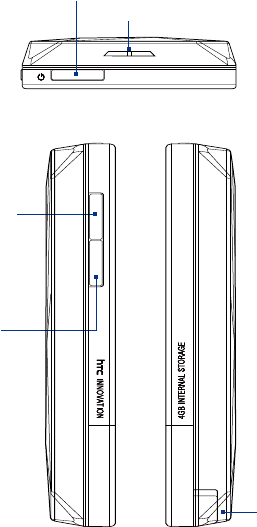
22 Getting Started
1.1 Getting to Know Your Touch Phone and
Accessories
Top panel
POWER
Press to turn off the display temporarily. To turn off
the power, press and hold for about 5 seconds.
For more information, see “Starting Up” in this chapter.
Speaker
Left panel Right panel
VOLUME UP
During a call or when
playing music, press this
button to increase the
volume.
VOLUME DOWN
During a call or when
playing music, press
this button to lower the
volume.
Stylus
(See “Stylus” in this
chapter for details.)
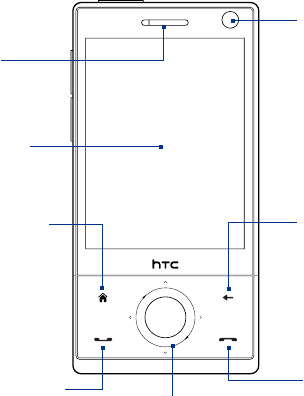
Getting Started 23
Front panel
Earpiece
Listen to a phone
call from here.
Touch Screen
HOME
Press to return to
the Home screen.
See Chapter 3 for
details.
END
• Press to end a call or
return to the Home
screen.
• Press and hold to lock
the device.
(See “Long Press End
Key” under “Settings on
your Device” in Chapter
13 for details.)
BACK
Press to return to the
previous screen.
Second Camera
Use this camera for
video call conversations
or to take a self-portrait.
Navigation Control
This Navigation Control
is both press-sensitive
and touch-sensitive.
See “Navigation Control”
later in this chapter for
details.
TALK/SEND
Press to answer an
incoming call or
dial a number.
During a call, press
and hold to toggle
the speakerphone
on and off.
Press and hold to
use Voice Speed
Dial. (See Chapter
12 for details.)
•
•
•
Notes When using the four buttons — HOME, BACK, TALK/SEND, and END — and
the Navigation Control, please observe the following precautions:
• Make sure to press on the icons of the four buttons for the best accuracy.
When pressing on the Navigation Control, make sure to press the outer
areas near the ENTER button for directional control.
• For best results, press with your fingertip. Do not wear gloves.
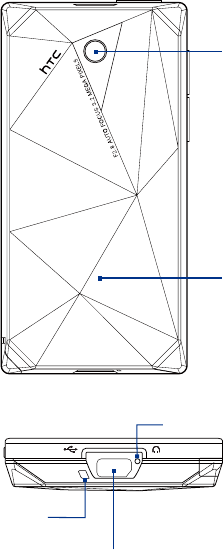
24 Getting Started
Back panel
Back Cover
Push the back cover
upward to remove it.
3.2 Megapixel Camera
See “Taking Photos and
Videos” in Chapter 11
for details.
Bottom panel
Sync Connector/Earphone Jack
Connect the supplied USB cable to synchronize information
or plug in the AC adapter to recharge the battery. You can
also connect the supplied USB stereo headset for hands-free
conversation or for listening to audio media.
Microphone
Strap Holder
See “Using the Strap Holder” in
this chapter for details.
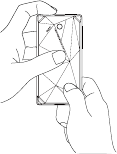
Getting Started 25
Accessories
The product package includes the following items and accessories:
Battery
AC adapter
Screen protector
Stereo headset
USB sync cable
Quick Start Guide and TouchFLO 3D Guide
Getting Started and Application discs
Extra stylus
1.2 Installing the SIM Card and Battery
Always turn off your device before installing or replacing the SIM card and
battery. You also need to remove the back cover before you can install these
components.
To remove the back cover
Make sure your device is turned off.
Hold the device with both hands and the
front panel facing down.
Push the back cover up with your thumb
until it disengages from the device and then
slide it up to remove.
1.
2.
3.
SIM card
The SIM card contains your phone number, service details, and phonebook/
message memory. Your device supports both 1.8V and 3V SIM cards.
Note Some legacy SIM cards may not function with your device. You should
consult with your service provider for a replacement SIM card. There may be
fees for this service.
•
•
•
•
•
•
•
•
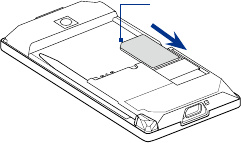
26 Getting Started
To install the SIM card
Make sure your device is
turned off.
Locate the SIM card slot, then
insert the SIM card with its
gold contacts facing down
and its cut-off corner facing
out the card slot.
Slide the SIM card completely
into the slot.
1.
2.
3.
Cut-off corner
SIM CARD
To remove the SIM card
Remove the battery if it is installed.
Slide the SIM card out from the SIM card slot with your thumb.
Battery
Your device comes with a rechargeable Lithium-ion or Lithium-ion polymer
battery and is designed to use only manufacturer-specified original
batteries and accessories. Battery performance depends on many factors,
including network configuration, signal strength, the temperature of the
environment in which you operate your device, the features and/or settings
you select and use, items attached to connecting ports, and your voice,
data, and other program usage patterns.
Battery life estimates (approximations):
Standby time: Up to 285 hours for GSM
Up to 396 hours for WCDMA
Talk time: Up to 330 minutes for GSM
Up to 270 minutes WCDMA
Video call time: Up to 145 minutes for WCDMA
Note Battery life is subject to network and phone usage.
1.
2.
•
•
•
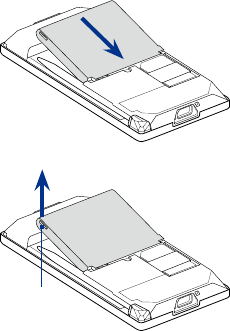
Getting Started 27
Warning! To reduce risk of fire or burns:
• Do not attempt to open, disassemble, or service the battery pack.
• Do not crush, puncture, short external contacts, or dispose of in fire
or water.
• Do not expose to temperatures above 60oC (140oF).
• Replace only with the battery pack designated for this product.
• Recycle or dispose of used battery as stipulated by local
regulations.
To install the battery
Align the battery’s exposed
copper contacts with the battery
connectors inside the battery
compartment.
Insert the contact’s side of the
battery first and then gently push
the battery into place.
Replace the back cover.
1.
2.
3.
To remove the battery
Make sure your device is turned off.
Remove the back cover.
The top left and right sides of the
battery have protruding grips. Lift a
protruding grip from either side to
remove the battery.
1.
2.
3.
Battery grip
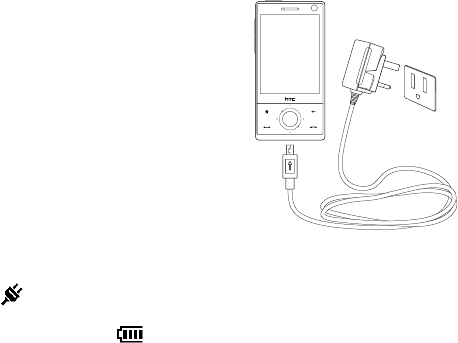
28 Getting Started
1.3 Charging the battery
New batteries are shipped partially charged. Before you start using your
device, it is recommended that you install and charge the battery. Some
batteries perform best after several full charge/discharge cycles.
To charge the battery
Connect the USB connector of the
AC adapter to the sync connector
on your device.
Plug in the AC adapter to an
electrical outlet to start charging
the battery.
Note Only the AC adapter and USB sync
cable provided with your device
must be used to charge the device.
1.
2.
1
2
Charging is indicated by a “breathing” white light around the Navigation
Control. As the battery is being charged while the power is on, a charging
icon also appears in the title bar of the Home screen. After the battery
has been fully charged, the Navigation Control LED shows a solid white light
and a full battery icon appears in the title bar of the Home screen.
For more information about the Navigation Control LED, see “LED Alerts” in
this chapter.
Warning! • Do not remove the battery from the device while you are charging it
using the AC or car adapter.
• As a safety precaution, the battery stops charging when it overheats.
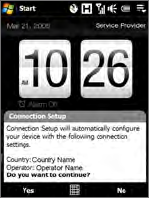
Getting Started 29
1.5 Starting Up
After installing your SIM card and battery and charging the battery, you can
now power on and start using your device.
Turn your device on and off
To turn on the power
Press and hold the POWER button for a few seconds.
When you turn on your device for the first time, a Quick Start Wizard
guides you to set up regional settings, date and time, and password.
For more information about these settings, see Chapter 13. After the
Quick Start Wizard finishes, the device installs customization settings,
then restarts.
Note After the device restarts, you may be prompted to set up an e-mail account.
For instructions on how to set up an e-mail account, see Chapter 6.
To turn off the power
Press and hold the POWER button for a few seconds.
Tap Yes when a message prompts you to choose whether or not to
turn off the device completely.
Auto configure the data connection settings
The first time you power on your device,
you will see a notification message from
Connection Setup. Connection Setup
automatically configures your device’s data
connections, such as 3G/GPRS, WAP, and MMS,
so that you do not need to enter the settings
manually for your device.
To automatically configure data connection
settings
1. When you see the notification message
from the Connection Setup,
tap Yes.
1.
2.
1.
2.

30 Getting Started
Note If you do not see the notification message, tap on the title bar to
display the message.
2. If your SIM card supports multiple network operator profiles, a
message will appear with network profile choices. Select the profile
you want to use and tap OK.
3. Connection Setup then starts to configure your device’s data
connection settings.
4. After the Connection Setup completes the configuration, tap Restart.
For more information about Connection Setup, see Chapter 13.
Switch to Sleep mode when not in use
Press and immediately release the POWER button to turn off the display
temporarily and switch your device to Sleep mode. Sleep mode suspends
your device to a low power state while the display is off in order to save
battery power.
Your device automatically goes into Sleep mode when you leave the device
idle after a certain period of time. You will still be able to receive messages
and calls while your device is in Sleep mode. Pressing the POWER button
again or incoming calls/messages will wake up your device.
Getting Started 31
1.6 Navigating Your Device
There are different ways you can navigate and interact with the interface of
your device.
Finger-touch control
A quick and easy way to interact with the home screen and the whole
interface of your device is by touch. Basically, the following are the types of
actions, called finger gestures, you would use when interacting with your
device:
Touch or tap
When selecting items on the screen, such as the Home screen tabs, Start
menu, programs and settings icons, and large on-screen buttons, simply
touch them with your finger. Apply some pressure with your finger pad
when touching an item on the screen.
Tapping means to touch lightly and quickly with your finger pad or
fingertip. On screens that display smaller-size items, you can more
accurately select an item by tapping it with your fingertip.
Swipe
To swipe means to drag your finger vertically or horizontally across the
screen. The following are some instances when you would use swiping:
Flipping on the Home screen
Swipe your finger vertically to flip through favourite contacts,
messages, music albums, photos, and more. For more information,
see “Using the TouchFLO 3D Home Screen” in Chapter 3.
Scrolling
When browsing the contacts list, web pages, documents, and certain
selection lists on the Home screen (such as the All Programs list),
slowly swipe your finger vertically across the screen to scroll. This
allows you to scroll by page and to view the content or available
selections as you scroll.
The direction of swiping resembles the way you move a printed
document as you are reading it. For detailed instructions, see “Finger
scrolling” in Chapter 3.
•
•
32 Getting Started
Slide
Sliding on the touch screen also involves dragging with your finger, but you
need to press and hold your finger with some pressure before you start to
drag. While dragging, do not release your finger until you have reached the
target position.
The following are some instances when you would use sliding:
Switching between Home screen tabs
Slide your finger left and right to switch between the Home screen
tabs. For more information, see “Using the TouchFLO 3D Home
screen“ in Chapter 3.
Advancing playback
In players that have a progress bar, such as the Home screen’s Music
tab and Windows Media® Player Mobile, slide your finger horizontally
on their progress bar to advance forward or move backward in the
music or video you are playing.
For more information about the Home screen’s Music tab, see “Music”
in Chapter 3.
For more information about Windows Media® Player Mobile, see
“Using Windows Media® Player Mobile” in Chapter 11.
Flick
Flicking the screen is similar to swiping, except that you need to swipe your
finger in light, quicker strokes. This finger gesture is always in a vertical
direction, such as when flicking the contacts list. See “Finger scrolling” in
Chapter 3 for details.
Finger zooming and panning
In programs such as Album and Opera Mobile, you can use finger gestures
when zooming and panning. See Chapter 3, 8 and 11 for details.
•
•
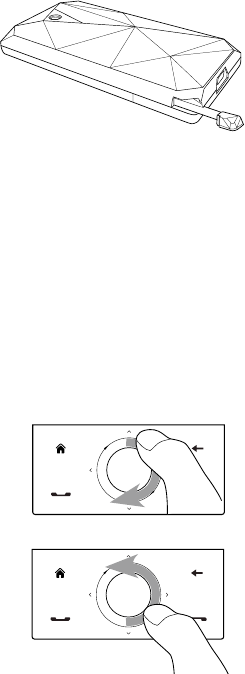
Getting Started 33
Stylus
You can use the stylus to navigate
and interact with the touch screen.
To use the stylus, pull it out from the
stylus compartment at the bottom
of the right panel of your device.
If the backlight is off, removing
the stylus automatically turns the
backlight back on.
The stylus is magnetic and sticks to the side when held close to the device.
This prevents you from accidentally losing or misplacing the stylus.
Basically, you tap with the stylus to open programs and select items on the
screen, and you tap and hold on the screen to open a shortcut menu. You
can also use the stylus the same way as what you do with finger gestures,
such as swiping, sliding and flicking on the screen.
Navigation Control
On the home screen and in many programs on your device, you can use
the Navigation Control for directional control. Press the directional arrows
to navigate up, down, left, and right on the screen. When an item has been
selected on the screen, press the ENTER button (the center button) to
confirm your selection.
The Navigation Control is also touch
sensitive and can be used for zooming.
Slide your finger clockwise around
the Navigation Control to zoom in,
counterclockwise to zoom out.
The following programs allow you
to use the Navigation Control for
zooming:
Album
Camera
Opera Mobile
Word Mobile and Excel Mobile
•
•
•
•
Sliding your finger clockwise
Sliding your finger
counterclockwise
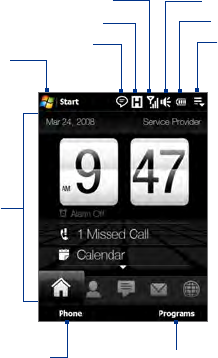
34 Getting Started
Tip If you purchase and install GPS navigation software on your device, you can
also use the Navigation Control for zooming in the GPS software.
On the Home screen’s Music tab, you can advance forward in the music you
are playing by sliding clockwise around the Navigation Control. To move
backward in the music, slide counterclockwise. See “Music” in Chapter 3 for
details.
1.7 Home Screen
The default home screen of the device is the TouchFLO™ 3D Home screen
which allows finger-touch access to the most important functions such as
contacts, text messages, e-mail, Internet, and more.
Start menu
Notification
Signal strength Adjust volume
Battery status
TouchFLO 3D
Home screen
Connection status
Open the Phone screen
(See Chapter 2 for details)
Go to the Programs tab to
access favourite programs
Quick menu
For more information about using the TouchFLO 3D Home screen, see
Chapter 3.
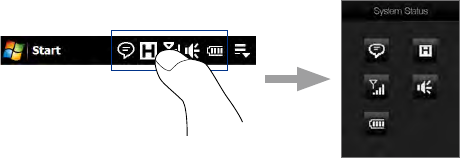
Getting Started 35
1.8 Status Icons
When you touch or tap the icon area of the title bar, the System Status
screen opens and displays larger status icons so you can touch them with
your finger more easily and accurately.
Tip The System Status screen can be disabled in TouchFLO settings. See “Settings
on your Device” in Chapter 13 for details.
The following are some of the status icons that you may see on the device.
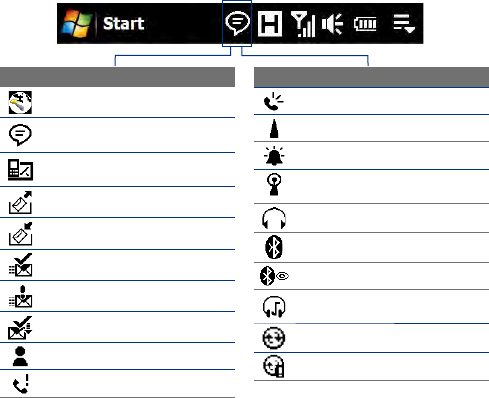
36 Getting Started
Icons that appear in this area
Connection Setup
Multiple notifications; tap the
icon to view all
New text messages;
SMS notification of voice mail
Sending MMS
Receiving MMS
MMS sent
Cannot send MMS
New incoming MMS
New Windows Live™ message
Missed call
Icons that appear in this area
Speakerphone on
Roaming
Alarm
Other wireless network(s)
detected
Wired headset connected
Bluetooth on
Bluetooth visible mode on
Bluetooth stereo headset
connected
ActiveSync notification
Synchronization error
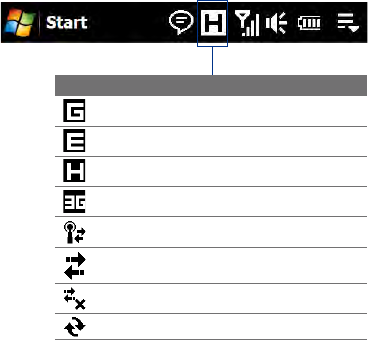
Getting Started 37
Icons that appear in this area
GPRS available
EDGE available
HSDPA available
WCDMA/UMTS available
Connected to a wireless network
Connection is active
Connection is not active
Synchronization in progress
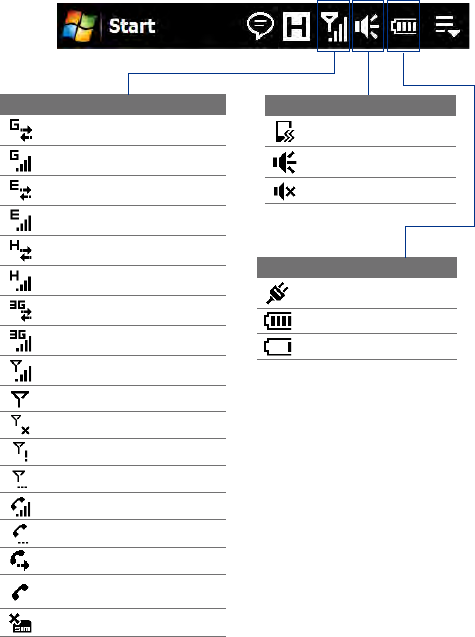
38 Getting Started
Icons that appear in this area
Battery charging
Battery full
Battery very low
Icons that appear in this area
Vibrate mode
Sound on
Sound off
Icons that appear in this area
GPRS connecting
GPRS in use
EDGE connecting
EDGE in use
HSDPA connecting
HSDPA in use
WCDMA/UMTS connecting
WCDMA/UMTS in use
Maximum signal strength
No signal
Phone is turned off
No phone service
Searching for phone service
Voice call in progress
Call on hold
Calls are forwarded
Dialing while no SIM card is
inserted
No SIM card inserted
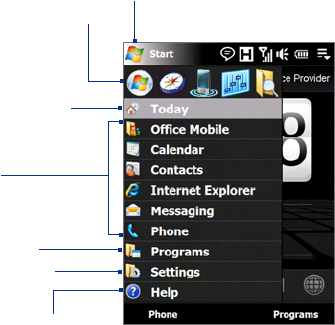
Getting Started 39
1.9 Start Menu
The Start menu, which can be opened from the top left corner of the screen,
gives you access to all the programs and settings of your Windows Mobile-
powered device. Touch or tap to select an item on the Start menu.
View Help information for the
current screen.
View and change settings.
Access more programs.
Open a recently-used program.
Open a program.
When you are on another
screen, touch or tap this item
to return to the TouchFLO 3D
Home screen.
Open the Start menu.
By default, the Start menu is displayed in a large size to make it easier
for you to touch menu items with your finger when selecting them from
the Start menu. The Start menu can also be displayed in a smaller size, if
preferred. Tap Start > Settings > System tab > TouchFLO and then clear
the Enable large Start menu check box to display a smaller Start menu.
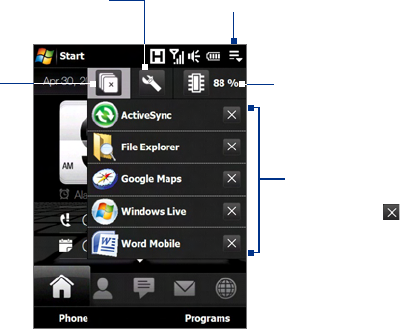
40 Getting Started
1.10 Quick Menu
The Quick menu, which can be opened from the top right corner of the
screen, shows the currently running programs. You can quickly switch
between running programs, stop programs, and see how much program
memory is being used.
Touch this icon to open
the Quick Menu.
• To switch to a running
program, touch the
program name.
• To stop a running
program, touch .
Customize Task Manager settings.
(See “Using Task Manager” in
Chapter 13.)
Stop all
currently
running
programs.
Shows the total percentage
of program memory in use.
Touch to open the Memory
settings screen.
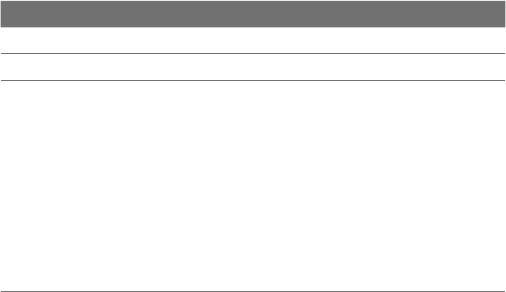
Getting Started 41
1.11 LED Alerts
The buttons below the touch screen and the exterior edge of the
Navigation Control which is an LED ring will light up in the following
situations:
Controls Light Behavior
SEND button Light flashes when there is an incoming call.
END button Light stays solid when there is an incoming call.
Navigation Control The LED ring shows a “breathing” white light when the
battery is being charged.
The LED ring shows a solid white light when the battery is
fully charged.
The LED ring flashes a white light once when the battery
level is low and reaches down to about 10%.
The top and bottom parts of the LED ring flashes a white
light twice when there is a new e-mail, voice mail, or
meeting reminder.
A white light goes around the LED ring counterclockwise
twice starting from the top when there is a missed call or
new SMS or MMS message.
•
•
•
•
•
The LED ring, HOME, BACK, SEND, and END buttons will flash a white light
once when one of the buttons or Navigation Control is pressed.
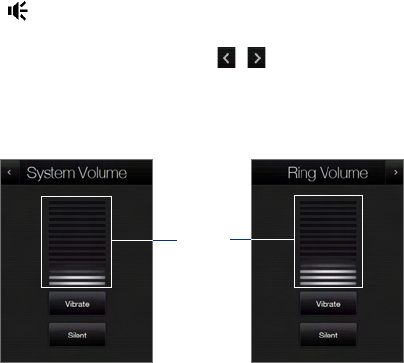
42 Getting Started
1.12 Adjusting the Volume
Adjusting the system volume changes the volume level of sound
notifications and audio/video playback, whereas adjusting the ring volume
affects only the volume of the phone ring. The system volume and ring
volume can be separately adjusted.
1. Touch the icon area in the title bar and then touch the Speaker icon
( ) on the System Status screen.
2. To switch between the Ring Volume and System Volume screens,
touch the Back and Next icons ( / ) on top of the screen.
3. On either screens, you can do the following:
• To increase or decrease the volume level, drag your finger up or
down the volume bars. You can also press the VOLUME UP/DOWN
buttons on the left panel of your device.
Volume
bars
• Touch Vibrate to enable or disable Vibrate mode.
• Touch Silent to mute both the system and ring volume.
4. The System Volume or Ring Volume screen automatically closes. You
can also manually close the screen by touching the screen.
Note On certain screens that do not show the volume status icon on the title
bar, you need to use the VOLUME UP/DOWN buttons on the left panel of
your device to adjust the volume. Also use these buttons to adjust the
conversation phone volume during an ongoing call.
Getting Started 43
1.13 Using your Device as a USB Drive
To easily carry media and other files with you, you can use the internal
storage of your device as a USB flash drive. Touch Start > Settings >
Connections tab > USB to PC and then select Disk Drive mode. This allows
you to copy files from your computer to the device and vice versa faster.
When Disk Drive mode is used:
You will not be able to use your device to access files from the internal
storage while it is connected to your PC.
Your PC will only connect to the device’s internal storage. When you
access your device from the PC, you will only see the contents of the
device’s internal storage.
Remember to change back to ActiveSync mode when you need to
synchronize data between your device and your PC.
•
•
44 Getting Started

46 Using Phone Features
2.1 Using the Phone
Like a standard mobile phone, you can use your device to make, receive,
and keep track of calls and send messages.
The Phone screen
To open the Phone screen, do one of the following:
• On the Home screen, tap
Phone.
• Press the TALK/SENDTALK/SEND
button.
TALK/SEND
button
Enter your PIN
Most SIM cards are preset with a PIN (personal identification number) that is
provided by your wireless service provider.
1. Enter the preset PIN assigned by your wireless service provider.
2. Tap Enter.
Note If you entered the wrong PIN three times, the SIM card will be blocked. If this
happens, you can unblock it with the PUK (PIN Unblocking Key) obtained
from your wireless service provider.
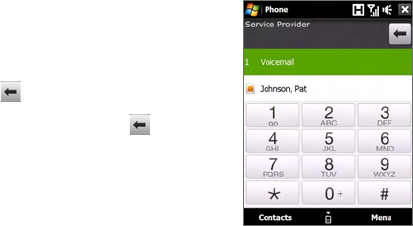
Using Phone Features 47
2.2 Voice Call
Make a call
To make a call from the Phone screen
1. On the Home screen, tap Phone.
2. Tap the keys on the keypad to enter
the phone number.
Tip If you tapped a wrong number, tap
to erase each subsequent digit
of a number. To erase the entire
number, tap and hold .
3. Press the TALK/SEND button to placeTALK/SEND button to place
the call.
Tip When in a call, use the VOLUME
UP/DOWN buttons on the side of
the device to adjust the phone
volume.
Note After tapping 6 keys and the number you are dialing is not in your contacts,
a Save to Contacts? button will appear above the keypad. Tap it to save the
number to your Contacts.
To make a call from Contacts
On the Home screen, tap Start > Contacts to open the Contacts screen.
Do one of the following:
• Select the contact to call and then press TALK/SEND.
Note If the contact has more than one number stored, press NAVIGATION
right/left to select the number you want to call before pressing TALK/
SEND.
• Tap the contact to open the contact details and then tap the phone
number you want to call.
• Tap and hold the contact you want to call and then from the menu,
select Call Work, Call Home, or Call Mobile.
To make a call from the TouchFLO 3D Home screen
Refer to Chapter 3 to learn how to make a call from the TouchFLO 3D Home
screen.
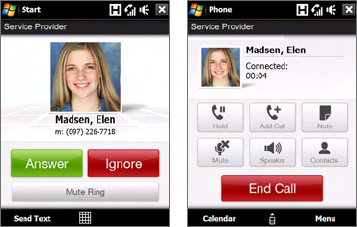
48 Using Phone Features
To make an emergency call
Enter the international emergency number for your locale, and press the
TALK/SEND button on your device.
Tip Additional emergency numbers may be included in your SIM card. Contact
your wireless service provider for details.
To make an international call
1. Tap and hold the number 0 key on the Phone screen until the plus (+)
sign appears.
The plus (+) sign replaces the international prefix of the country that
you are calling.
2. Enter the full phone number you want to dial, and press the
TALK/SEND button on your device. The full phone number includes
the country code, area code (without the leading zero, if any), and
phone number.
To call voice mail
Number 1 is generally reserved for your voice mail. Tap and hold this
button on the Phone screen keypad to call voice mail and retrieve your
voice mail messages.
Answer a call
When you receive a phone call, a message will appear, giving you the
option to either answer or ignore the incoming call. The TALK/SEND button
will also flash when you receive a call.

Using Phone Features 49
To answer or reject an incoming call
• To answer the call, tap Answer, or press the TALK/SEND button.
• To reject the call, tap Ignore, or press the END button.
• To mute the ringing sound without rejecting the call, tap Mute Ring.
Tip You can also place your phone face down to mute the ring without rejecting
the call.
To reject a call and send a text message
When you reject a call, you can choose to automatically send a text
message to the mobile phone of the caller.
1. On the Phone screen, tap Menu > Options > Advanced tab.
2. Select the Reject call with text message check box.
3. Change the default text message if needed, then tap OK.
When Reject call with text message is enabled, tap Send Text to reject the
call and send the text message to the caller.
To put a call on hold
Your device notifies you when you have another incoming call, and gives
you the option of rejecting or accepting the call. If you are already on a call
and accept the new call, you can choose to switch between the two callers,
or set up a conference call between all three parties.
1. Tap Answer to take the second call, and put the first one on hold.
2. To end the second call and return to the first call, tap End Call or press
END on your device.
To switch between two calls
During a call, tap .
To set up a conference call
1. Either put a call on hold, and dial a second number; or, accept a
second incoming call when you already have one in progress.
Tip To dial a second number, tap on the screen.
2. Tap .

50 Using Phone Features
Note Not all mobile phone networks support conference calling. Contact your
wireless service provider for details.
To turn on and off the Speakerphone
During a call, tap to toggle between turning on or off the
speakerphone. The speakerphone icon appears in the title bar when the
speakerphone is on.
Tip You can also press and hold TALK/SEND to toggle between turning on or off
the speakerphone.
Warning! To avoid damage to your hearing, do not hold your device against your
ear when the Speakerphone is turned on.
To mute the microphone during a call
Tap to toggle between turning on or off the microphone. When the
microphone is turned off, the mute icon appears on the screen.
To open Notes while in a call
Tap or pull out the stylus.
To vibrate the device when the call is established
You can set the device to vibrate once to alert you that the call has been
established with the other party.
1. On the Phone screen, tap Menu > Options >Advanced tab.
2. Select the Vibrate device when connection is established check
box and then tap OK.
End a call
When a call is in progress, tap End Call or press the END button to hang up.
To add a new phone number to Contacts after a call
If the phone number of the person who called is not in Contacts, you can
choose to save the number after you hang up.
1. On the Phone screen, tap Menu > Options > Advanced tab.
2. Select the Add new phone number to Contacts at end of call check
box, then tap OK.

Using Phone Features 51
When you enable this option, a pop-up message appears after you end the
phone call and lets you add the phone number to Contacts.
To check a missed call
You will see the icon in the title bar when you missed a call. To check who
the caller was, do one of the following:
• Tap the title bar, then tap and then tap View.
• On the Phone screen, tap Menu > Call History and then tap .
Call History
Use Call History to check for missed calls, dialed numbers, and calls
received. To open the Call History screen, tap Menu > Call History on the
Phone screen.
Speed Dial
Use Speed Dial to call frequently-used numbers with a single tap. For
example, if you assign a contact to the location 2 in Speed Dial, you can
tap and hold the number 2 key on the Phone screen keypad to dial the
contact’s number.
To create a Speed Dial entry
1. On the Phone screen, tap Menu > Speed Dial.
2. Tap Menu > New.
3. Tap a contact, then select the phone number of the contact that you
want assigned to the speed dial key.
4. In Location, select an available key to use as the speed dial key.
5. Tap OK.
Note When you assign a new phone number in an occupied speed dial key, the
new phone number will replace the existing one.
Tips • To create a Speed Dial entry from Contacts or SIM card contacts, tap
the contact, select the number you want to add to Speed Dial, then tap
Menu > Add to Speed Dial.
• To delete a Speed Dial entry, in the Speed Dial list, tap and hold the
desired entry, then tap Delete.
52 Using Phone Features
Turn the phone function on and off
In many countries, you are required by law to turn off the phone while on
board an aircraft.
To enable or disable the phone function
1. Tap Start > Programs > Comm Manager.
2. On the Comm Manager screen, tap the Phone button to enable
or disable the phone function. When enabled, the ON indicator is
activated.
To enable or disable Airplane Mode
Another way to turn off the phone function is to switch your device to
Airplane Mode.
When you enable Airplane Mode, all wireless radios on your device are
turned off, including the phone function and Bluetooth.
When you disable Airplane Mode, the phone function is turned back on and
the previous state of Bluetooth is restored.
1. Tap Start > Programs > Comm Manager.
2. On the Comm Manager screen, tap the Airplane Mode button to
enable or disable Airplane Mode. When enabled, the ON indicator is
activated.
Using Phone Features 53
2.3 Video Call
Your device lets you make video calls when you are within a 3G network
coverage area. You need to use a 3G-enabled SIM card to make video calls.
Make a video call
Do one of the following:
• On the Phone keypad, tap the phone number to call, then tap
Menu > Video Call to start a video call.
• From Contacts, tap and hold the desired contact, and tap Video Call.
• From Call History, tap and hold the desired phone number or contact,
and tap Video Call.
Note The other party’s image will appear on the screen about 3 to 5 seconds after
a connection is established, depending on the signal strength. The streaming
images quality may also be influenced by the signal.
When the video call is unsuccessful, a message pops up asking you if you
want to try again, make a voice call instead, or send an SMS/MMS message.
Answer a video call
To answer or reject an incoming video call
• To answer the video call, tap Answer, or press TALK on your device.
• To reject the video call, tap Ignore, or press END on your device.
• To mute the ringing sound without rejecting the call, tap Mute Ring.
When Reject call with text message is enabled in Phone settings, tap
Send Text to reject the call and send the text message to the caller.
Tip You can also place your phone face down to mute the ring without rejecting
the call.
End a video call
Once a video call is in progress, tap End Call to hang up.
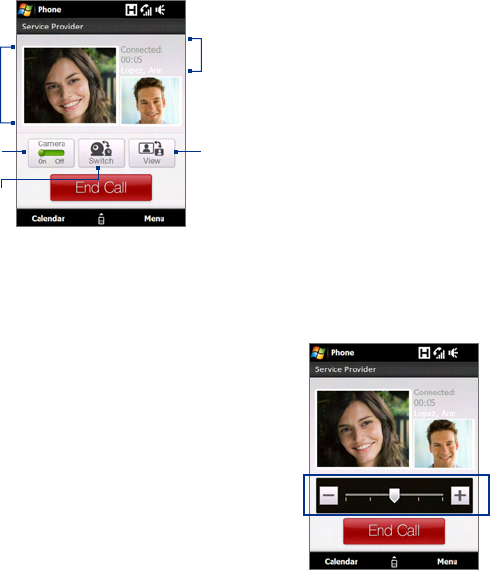
54 Using Phone Features
Change settings
While on a video call, you can change certain settings such as the size of the
image, brightness of the video image, the camera to use, and more.
The following shows the Video Call screen and control buttons during an
ongoing call.
1Image display area. Displays your image
and the other party's image, depending
on the selected Swap Image setting.
2Camera. Tap to toggle between turning
on/off the camera. When the camera is
turned off, the image displayed depends
on the Video Call options you have set.
See “Video call options” for details.
3Switch. Tap to toggle between using the
Main (back) and Second (front) camera.
4View. Tap to toggle between the 2 view
options. You can choose to have the
other party’s image small or large.
5Status area. Displays your service
provider name, the other party's
information, and call timer.
2
3
4
5
1
Brightness
To adjust the brightness of the live
image, press NAVIGATION right to
make it brighter or press NAVIGATION
left to make it less bright. When you
press NAVIGATION left or right during a
video call, a brightness bar appears on
the screen.
Notes • You can also tap Menu >
Brightness to adjust the
brightness of the live image.
• You cannot adjust the
brightness for a still image. Brightness bar
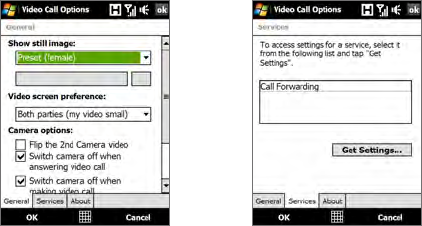
Using Phone Features 55
Video call options
On the Phone screen, or on the screen of the ongoing video call,
you can also tap Menu > Video Call Options and set the following options:
Video Call Options: Services tabVideo Call Options: General tab
General tab
•Show still image. Select the image you want to display when you
turn off the camera.
•Preset (female). Displays a female picture in place of your image.
•Preset (male). Displays a male picture in place of your image.
•Custom image. Lets you use an image file as your display picture.
When this option is selected, the is selected, the, the File Name box and the Browse
button will be enabled, allowing you to select an image file., allowing you to select an image file.
•Last video frame. Uses the last video frame before you stopped
the camera as your display image.
• Video screen preference. Change how your image and the other
party’s image are displayed on the screen, select your preference from
the Video screen preference list or tap the View button on the Video
Call screen.
• Camera options:
•Flip the 2nd camera video. Select this check box if you are going
to show a text document to the other party using the second
camera.
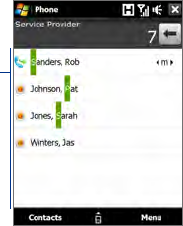
56 Using Phone Features
•Switch camera off when answering video call. Select this check
box to not send a video feed of yourself to the other party when
answering a video call. Instead, the option you selected in Show
still image will be displayed.
•Switch camera off when making video call. Select this check
box to not send a video feed of yourself to the other party when
making a video call. Instead, the option you selected in Show still
image will be displayed.
• Display info:
•Show call timer. Select this check box to display the call period in
the status area.
•Show phone number and name. Select this check box to display
the other party’s phone number and name in the status area.
Services tab
To set up further calling options for Video Call, tap the Services tab. On
the Services screen, select the desired service from the list, then tap Get
Settings to access its settings.
2.4 Smart Dial
Smart Dial makes it easy for you to
dial a phone number.
When you start entering a phone
number or contact name, Smart Dial
automatically searches and sorts the
contact entries on the SIM card, in
Contacts, and the phone numbers
in Call History (including incoming,
outgoing, and missed calls). You can
then select the desired number or
contact from the filtered list to dial.
Smart Dial
panel

Using Phone Features 57
To find a contact name or number
You can just enter the first letter of the name or number of a contact.
Smart Dial will search for contact phone numbers and the first character
of a contact name as well as from the character that appears after a space,
dash, or underscore in a contact name. For example, if you tap number “2”
on the phone keypad, which is associated with [a, b, and c] on the Phone
keypad, contact names such as the following will be considered matches:
“Ben Miller”, “George Adams”, “John-Carter”, “Carter, Ellen”, “Dixon, Allan”,
“Thomas_Clark”, “JaneCampbell”.
If the matching list is long and you want to narrow down the search further,
enter another letter. Using the same example above, if you continue to
tap “3” which is associated with [d, e, f], the matching list will be narrowed
down to the following names: “Ben Miller”, “George Adams”, “Carter, Ellen”,
“Dixon, Allan”.
Make a call or send a text message using Smart Dial
1. On the Home screen, tap Phone.
2. Begin entering the first few numbers or characters.
When you start entering a number or letter, the Smart Dial panel will
display matches found.
Tip Tap to close the phone keypad and to see if there are more matching
contacts.
3. In the Smart Dial panel, flick and slide your finger on the touch screen
or press NAVIGATION up/down to browse the list or select a contact.
4. You can do one of the following:
• Tap the contact to call the selected contact.
• To send a text message to the selected contact, tap Menu > Send
Text Message.
• To call a different phone number associated with the selected
contact, select the contact and then press NAVIGATION left/right
to select the number to call.
58 Using Phone Features
2.5 Setting Up Bluetooth SIM Access for Car Kit
Phones
Bluetooth car kits that support the SIM Access Profile (SAP) can connect to
your device and access its SIM card via Bluetooth. Once a SAP connection
has been established, you can download SIM contacts from your device to
the car kit phone. You can also use the car kit phone to answer and make
calls using your device’s SIM card.
Note To enable downloading contacts onto the car kit, ensure that all contacts
on the device are stored in the SIM card and not in the device memory.
Configure the car kit to download contacts only from the SIM card.
1. On your device, make sure that Bluetooth is turned on and set to
visible mode. For information about turning on Bluetooth and
enabling visible mode, see “Bluetooth Modes” in Chapter 9.
2. On the Home screen, slide to the Settings tab and then tap Menu >
Bluetooth Devices > SIM Access tab.
3. Select the Remote SIM Access check box, then tap OK.
4. Connect the car kit phone to your device via Bluetooth. To learn how
to connect, consult your car kit phone’s manual.
5. If this is the first time you are pairing the car kit phone with your
device, enter the car kit’s passcode on your device.
6. A pop-up message should appear on your device saying that a
connection has been established between your device and car kit
phone. Tap OK.
7. On the Bluetooth screen, tap the SIM Access tab, then tap Connect.
Note You will not be able to make/receive calls, send/receive messages or perform
related activities on your device when the SIM Access Profile connection is
active. You’ll be able to do all these from the car kit phone during this time.
After the connection is disconnected, you will be able to use your device as
before.
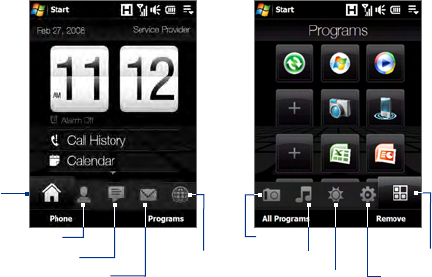
60 TouchFLO™ 3D
3.1 About TouchFLO™ 3D
TouchFLO™ 3D gives you touch control over your Windows Mobile-
powered device. TouchFLO 3D provides the following features:
A Home screen that allows finger-touch access to the most widely-
used functions, such as People, Messages, Mail, Music, Internet, and
more
Allows you to use finger gestures to navigate screens
3.2 Using the TouchFLO 3D Home Screen
The TouchFLO 3D Home screen have the following tabs:
Home
People
Messages
Mail
Photos and
Videos Music
Internet
Settings
Programs
Weather
To switch between the tabs of the Home screen
Do one of the following:
Touch or tap the desired tab on the Home screen.
Press Navigation Right or Left to move to the next or previous tab.
•
•
•
•
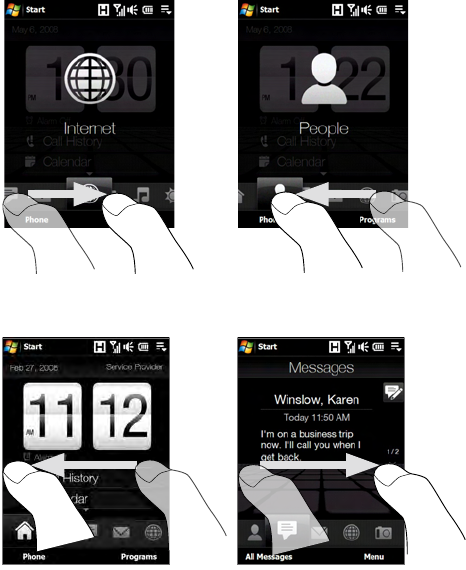
TouchFLO™ 3D 61
Press and hold your finger on the active tab, then slide your finger
right or left over the tabs. Release when you have selected the desired
tab.
Note Apply some pressure when pressing and holding on the active tab to be
able to slide over the tabs.
Swipe left across the screen to move to the next tab, and swipe right
across the screen to move to the previous tab.
•
•
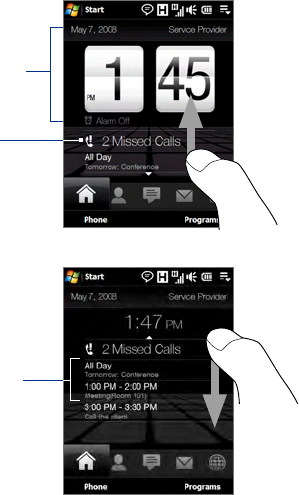
62 TouchFLO™ 3D
Home
The Home tab displays the current date, a flip-style clock, and an Alarm
icon that indicates whether the alarm is on or off. Missed calls and your
upcoming calendar appointments are also shown on the Home tab.
To select an item on the Home tab
Touch the item; or
Press Navigation Up or Down first to navigate to the item you want to
select and then press ENTER.
Touch the date or the flip
clock to open the Clock &
Alarms screen where you
can set the date, time, and
alarm.
(See Chapter 13 for details.)
Swipe upward
on the screen to
display the smaller
digital clock
and view more
appointments.
Touch this area to view
details about missed calls
in the Call History.
(See Chapter 2 for details.)
Home tab with flip clock
Swipe downward
on the screen to
change back to
the flip clock.
One all-day appointment
and up to two timed
appointments can be
displayed. Touch this area
to create, edit or view an
appointment.
(See “Calendar” in Chapter
12 for details.)
Home tab with smaller digital clock
•
•
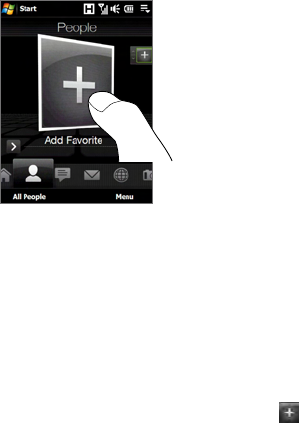
TouchFLO™ 3D 63
People
On the People tab, you can add favourite contacts who you most frequently
communicate with. This allows you to quickly make calls, send text
messages, and send e-mails to your favourite contacts.
Tip You can add up to 15 favourite contacts on the People tab.
To add favourite contacts
You should already have created or synchronized contacts on your device
before you can add them to the People tab.
1. On the Home screen, slide your finger to the People tab.
2. Touch the small or big Plus icon, or touch Add Favourite.
3. On the Select a Contact screen, touch the name of the desired
contact.
Tips • To create a new contact, touch Menu > New Contact. See “Contacts”
in Chapter 12 for details.
• SIM contacts cannot be added as favourite contacts.
4. Select a phone number or e-mail address to associate to the favourite
contact.
Note If there is no picture associated with the contact, the next screen
prompts you to assign a picture to the contact.
5. To add another favourite contact, touch the small Plus icon ( ) at
the right side of the screen and repeat steps 3 and 4.
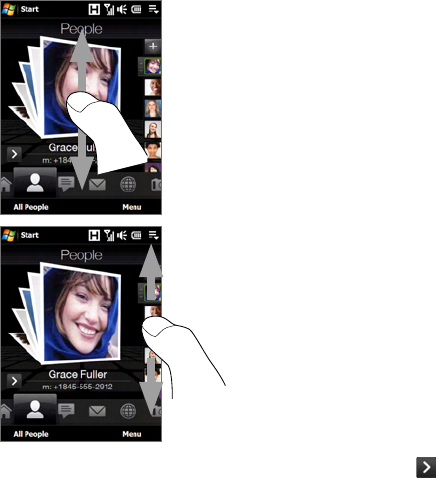
64 TouchFLO™ 3D
To choose from your favourite contacts
Do any of the following:
To flip through the contact pictures
one at a time, swipe your finger up or
down the screen. You can also press
Navigation Up or Down to flip through
the contact pictures.
On the picture strip at the right side of
the People screen:
Touch the picture of the desired
favourite contact; or
Press and hold on the currently
selected contact picture to
display a slide-out bar, and then
slide up or down the picture
strip. Release your finger when
the desired favourite contact is
selected.
•
•
After selecting a favourite contact, touch the right arrow icon (
), the phone number or e-mail address shown below the contact
picture to place a call, send a text message, or send an e-mail to the
contact.
Touch the picture of the contact on the center screen to access his or
her contact card. On the contact card, you will see the last outgoing
or incoming call as well as contact details such as phone numbers,
e-mail address, and more.
Tips • On the People tab, touch All People to access SIM contacts and all
contacts that are stored on your device.
•
•
•
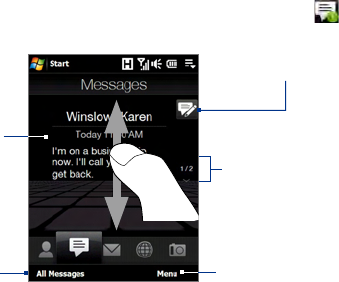
TouchFLO™ 3D 65
• To remove the current favourite contact, touch Menu > Remove
Favourite.
Messages
On the Messages tab, you can read SMS text messages as they arrive and
create a new SMS text message. You can also view the text of received MMS
messages on this tab.
When there are new incoming SMS/MMS messages, the icon on the
Messages tab will show the number of new messages. For example,
indicates that there is a new message received.
To view the entire
message thread from the
sender and reply, touch
the message on the
screen.
Touch All Messages to
access all text messages
in your inbox and other
folders.
Touch this icon to create
a new SMS text message.
To flip through received
SMS/MMS messages,
swipe your finger
upward/downward,
touch the Up/Down
arrow on the screen,
or press Navigation
Up/Down.
Touch Menu to remove
the current message and
access more options.
For more information about working with SMS and MMS messages, see
“Text Messages” and “MMS” in Chapter 6.
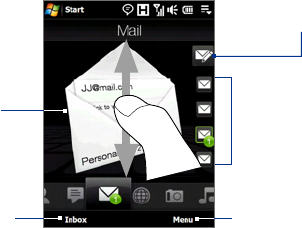
66 TouchFLO™ 3D
Mail
The Mail tab is where you send and receive e-mail messages. Including
Outlook E-mail, you can add up to four POP3/IMAP4 and web-based e-mail
accounts in this tab.
To add an e-mail account
1. On the Home screen, slide your finger to the Mail tab.
2. If this is your first time to add an e-mail account, touch New Account
on the bottom-right side of the screen.
3. Set up your e-mail account using the E-mail Setup wizard.
4. To add another e-mail account, touch Menu > Accounts > New
Account and use the E-mail Setup wizard to set up your account.
For detailed instructions on setting up e-mail accounts using the E-
mail Setup wizard, see Chapter 6.
To check e-mail
When there are new e-mails, the icon on the Mail tab and the respective
icons of the e-mail accounts will show the number of newly received
messages.
To browse through
received e-mails,
swipe up or down on
the envelope image
or press Navigation
Up/Down.
Touch the e-mail
on the screen to
open and read the
message.
•
•
Touch Inbox to access
all e-mail messages of
the currently selected
account.
After selecting an e-mail
account, touch this icon
to create and send a new
e-mail message.
These are your e-mail
accounts. Touch an
icon to select an e-mail
account and view the
new e-mails received in
that account.
Touch Menu to access
more options.
For more information about working with e-mails, see Chapter 6 and 7.

